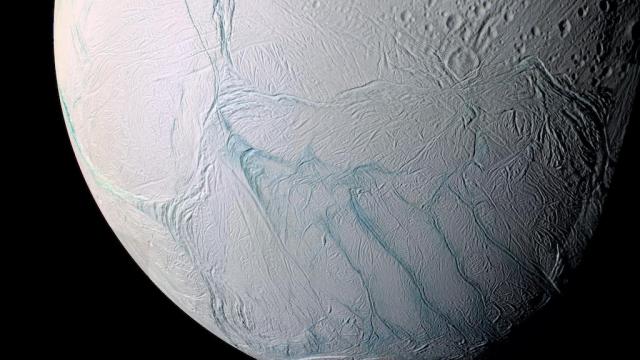Saturn’s moon Enceladus is a beautiful mystery. Though it looks like a lonely ice ball, this moon is concealing what’s probably an underground ocean, engulfing a rocky core. In fact, Enceladus’s south pole contains active jets that shoot out water vapour and icy particles from this ocean, which were first observed by NASA’s Cassini orbiter in 2005. These origin of these incredible jets, along with well-defined fractures along the south pole called “tiger stripes”, is still being debated — but a team of scientists at the Johns Hopkins University Applied Physics Laboratory have put forth an intriguing explanation.
Image: NASA/JPL/Space Science Institute
The team, which is led by Johns Hopkins post doctoral researcher Kate Craft, posits that sometime in the last 100 million years, a massive object smashed into the tiny moon, punching all the way through to the ocean. This epic smashup would have caused melting and fracturing.
When Enceladus did manage to refreeze, it left behind the trademark tiger stripes — and tidal stresses acting on the moon as it orbits Saturn keep those scars open, spewing heat and water vapour to this day. The researchers tested this idea by running a series of computer simulations, which confirmed that a collision could have caused the tiger stripes. The team presented their findings last week at the 48th Lunar and Planetary Science Conference in The Woodlands, Texas.
“The impact could have happened anywhere and then Enceladus would have rolled over until the impact point ended up at whichever pole happened to be nearest,” co-author Francis Nimmo from the University of California Santa Cruz told New Scientist. In other words, this hypothetical impact would have removed enough material to cause a gravitational anomaly — a region with less mass than its surroundings which, over time, would have gravitated toward one of the moon’s poles.
Enceladus is worth rigorously pursuing for many reasons. One is that it’s incredibly cool in every sense of the word — an icy world that shoots water from its geysers! Moreover, its underground ocean makes Enceladus a great candidate in the search for life outside Earth, perhaps the best. Hopefully, our next trip to Saturn and its moons will be an all-out alien hunt, so we’ll know soon enough if we have any company there.
